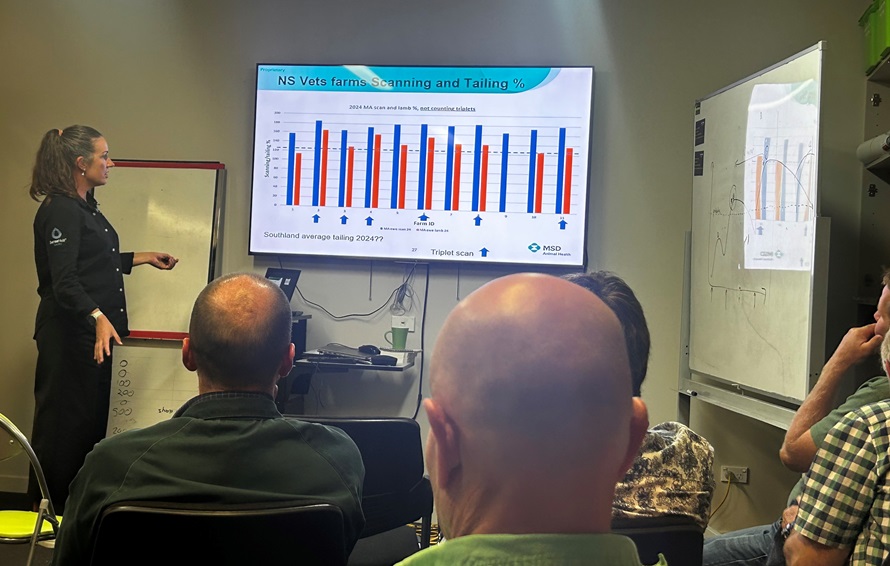Campylobacter Study Update

In Spring 2024 MSD Animal Health in partnership with Andrew Cochrane from Northern Southland Vets (NSVets) began a new study expected to run for three years looking at Campylobacter prevalence in mixed-age ewes and its impact on lamb wastage.
This blog is intended to capture updates on the study at regular intervals throughout the course of the study.
Click on the links below to jump to the blog post mentioned
- Background on Campylobacter
- Purpose of the study
- May 2025 Update – first farmer group catchup
- Testing Process and Estimated Costs
Background on Campylobacter
Campylobacter is commonly referred to as an “abortion” disease however Campylobacter-related abortion losses are just the tip of the iceberg with the vast majority of associated losses being not as obvious to spot. Early embryonic loss (resulting in dry ewes or late lambers), stillbirths and weak lambs are all associated with Campylobacter infection.
Currently in New Zealand, the majority of sheep flocks are vaccinated with a Campylobacter vaccine called Campyvax4®, although in most cases this is just an initial sensitiser and booster course given to maiden ewes with many not following best-practice and administering an annual booster to mixed-age ewes. While for most farmers it seems to make sense to protect younger stock as their immune systems are typically less developed to help fight against disease, there appears to be less understanding of the importance of protecting mixed-age ewes which are generally considered the powerhouse of sheep farming operations, producing the majority of the lambs and therefore are a key driver of farm productivity and profitability.
Trial work carried out in Marlborough in 2001 [1] analysed scanning and tailing data and responses of sheep flocks vaccinated with a Campylobacter vaccine. This study suggested that abortions may be just the ‘tip of the iceberg’ and of greater economic importance was reduced lamb numbers and lamb viability even when abortions were not observed.
Recent case studies from West Otago (Campylobacter Case Study – West Otago – NZ Sheep Vaccine (sheepvax.co.nz)) and Hawkes Bay (Campylobacter Case Study – Hawkes Bay – NZ Sheep Vaccine (sheepvax.co.nz)) support these findings with positive outcomes from the inclusion of an annual booster vaccination of Campyvax4®.
Purpose of the study
The purpose of this new study is to reinforce the findings from these previous studies that Campylobacter vaccination in mixed-age ewes is an important consideration for farmers & that in the current economic climate booster vaccinations of Campyvax4® provide a positive return on investment and should be considered an important part of every sheep farmer’s animal health plan.
Year 1 of this study involved blood testing 10 wet-dry mixed-age ewes who had not received a booster shot on 11 Southland sheep farms to test for recent exposure to Campylobacter, as well as gathering the farm’s scanning, tailing and weaning data for the last 3 seasons.
The above data is being reviewed to determine whether there is a correlation between flocks with recent exposure to Campylobacter and flocks with higher lamb wastage and will then be utilised to drive decisions on each farm on whether implementing a Campyvax4® booster vaccination program in mixed-age ewes is appropriate.
Our plan throughout this study is to continue to keep you updated with our findings as they come to hand, so please keep a look out for our next piece providing an overview of the initial results.
If you have any questions regarding this please follow up with your trusted veterinarian or contact MSD Animal Health on 0800 800 543.
[1] Anderson, P (2001) The Implications of Campylobacter Infections in Ewe Flocks. Proc 31st Annual Seminar, Society of Sheep and Beef Cattle Veterinarians, NZVA p31-40
NZ-CVX-250300001
May 2025 Update – first farmer group catchup
Recently a few members of our MSD Animal Health team had our first group catch up with the farmers participating in our Campylobacter Prevalence Study along with study lead, Andrew Cochrane from NS Vets. In this meeting Kim Kelly, local MSD Technical Vet, discussed what previous studies and lab data have told us about Campylobacteriosis in sheep and detailed to the study farmers what we have found out so far in our ongoing study.

Study statistics so far:
- 10 wet/dry mixed age ewes blood tested per farm (11 farms = 110 ewes)
- Blood test results showed that 90% of all ewes tested in the study had been naturally exposed to Campylobacter (compared to 48% found by Dempster 2011, however this was a random sample from all mixed age ewes, not just
wet/dry ewes) - 35% of all ewes tested had recently (last few months) been exposed to
Campylobacter (blood test titre of >1:160)
Figure 1: Percentage of ewes with titres >1:160 to each Campylobacter fetus fetus antigen

- Lamb wastage from scanning to tailing for the study farms was typically between 20-25% over the previous 3 seasons, slightly above the national average of 18-20%. However, these farms in general also scanned more lambs than the national average.
- Lamb Wastage = (Lambs Scanned – Lambs Tailed) / Lambs Scanned
- The study farms on average had:
- 1,814 mixed-age ewes
- 183% scanning
- 3,319 lambs scanned
Previous NZ case studies have shown an increase in lambing percentage associated with the administration of an annual booster with a Campylobacter vaccine. An increase in lambing percentage is great but what farmers really want to know is does that added vaccination provide a positive return on investment. Previous studies showed:
- Hawkes Bay Case Study: 2-4% increase in lambing percentage
- Marlborough Study (Anderson 2001): 9% average increase in lambing percentage
- West Otago Case Study: 5-10% increase in lambing percentage
Based on these previous case study results we could reasonably expect the following for our “average” study farm:
- 2% x 1,814 ewes = 36 lambs @ $125/lamb = $4,500
- 10% x 1,814 ewes = 181 lambs @ $125/lamb = $22,625
- Approximate cost of addition of Campyvax4® Annual Booster to 1,814 ewes = $1,560 incl GST
- Financial benefit annually of between $2,940 (2%) – $21,065 (10%)
Through discussion with their veterinarian and considering their farm’s Campylobacter blood test results, 3/11 of the study farms have begun administering an annual Campyvax4 booster in their mixed-age ewes. In some cases, if more than a year since they had a Campyvax4, this has required 2 vaccines 4-8 weeks apart pre-mating this season.
Anderson PV. The implications of campylobacter infections in ewe flocks. Proc 31st Annual Seminar, Society of Sheep & Beef Cattle Veterinarians NZVA, 2001.
Dempster et al. Serological survey of Toxoplasma gondii and Campylobacter fetus fetus in sheep from New Zealand, New Zealand Veterinary Journal, 59:4, 155-159, 2011.
AVAILABLE ONLY UNDER VETERINARY AUTHORISATION. ACVM No: A9535. NZ-CVX-250500001
Testing Process and Estimated Costs
We have had requests from a number of farmers and vets, who are following our
Campylobacter Prevalence Study, for details of the testing process and associated
costs so they can consider this for their own farms this coming Spring. This is detailed below.
Testing Process
- Retrieve 10 x wet/dry mixed-age ewes that have not been vaccinated with Campyvax4® for at least 2 years (i.e. if you vaccinated with Campyvax4 as hoggets only then then test as 4 tooths or older, or if last vaccinated as 2 tooths then test as 6 tooths or older).
- Why only blood test wet/dry ewes* not vaccinated for at least 2 years?
The immune response from recent vaccination (within the last 2 years) is difficult to distinguish from immune response from natural challenge. By only testing ewes not vaccinated for at least 2 years we can confidently use blood titres to show evidence of natural exposure to Campylobacter.
*Wet/dry ewes are ewes scanned in lamb but presenting at tailing without lamb(s)
- Why only blood test wet/dry ewes* not vaccinated for at least 2 years?
- Have your veterinarian take a blood sample from these ewes and send to their routine veterinary laboratory for Campylobacter Antibody Titre Testing.
- Review your blood test results with your veterinarian who will help interpret the results including whether there is evidence of recent infection and if so, what strains of Campylobacter were found.
- Historic scanning and tailing results can be used to calculate the scanning to tailing wastage which can then be compared to local benchmarks.
Lamb Wastage = (Lambs Scanned – Lambs Tailed) / Lambs Scanned - If there is significant Campylobacter present then your vet may discuss vaccinating your mixed age ewes with Campyvax4 to reduce Campylobacter-associated lamb wastage.
- Historic scanning and tailing results can be used to calculate the scanning to tailing wastage which can then be compared to local benchmarks.
- Review your ongoing scanning, tailing and lamb wastage results, taking into account seasonal changes (e.g. weather events which may have increased lamb deaths).
- If your flock is dealing with significant Campylobacter challenge, previous studies have shown vaccinating with Campyvax4 will likely result in significant increases to scanning and tailing percentages. This is what we are attempting to replicate with the results from our ongoing study.
Testing Cost Estimate
| Item | Cost (Excl GST) |
| Laboratory Testing | $600 |
| Vet visit fee, time and materials | $250 |
| Total* | $850 |
*This is an estimate and does not include a vet mileage charge as vet clinic to farm distance will vary significantly between farms. For an accurate quote, please talk to your local veterinarian.
If you have any questions regarding this please follow up with your trusted veterinarian
or contact the team at MSD Animal Health on 0800 800 543.
AVAILABLE ONLY UNDER VETERINARY AUTHORISATION. ACVM No.: A9535. NZ-CVX-250800003

